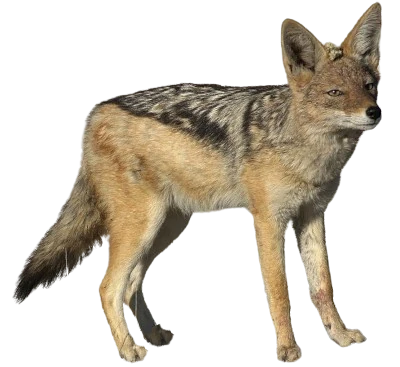
The Black-backed Jackal (Canis mesomelas) is a medium-sized canid native to African regions. It is distinguished by its slender build and black back, from which it derives its name. This animal plays an important ecological role as a predator and scavenger in its natural habitats.
The Black-backed Jackal stands between 45 and 55 cm at the shoulder and weighs between 7 and 11 kg. It has a short, dense coat that ranges from grey to black on the back, with lighter, often reddish-colored flanks and legs. Its slim build and long legs allow it to move quickly and with agility, which is essential for hunting. It has pointed ears and an elongated muzzle that are characteristic features.
The Black-backed Jackal (Canis mesomelas) belongs to the Canidae family.
Although it shares characteristics with other canids, the Black-backed Jackal is distinct from the Golden Jackal due to its smaller size and unique coloration. It belongs to the same genus, Canis, alongside the Golden Jackal, Grey Wolf, and Coyote.
The Black-backed Jackal is primarily found in the savannas and semi-arid regions of sub-Saharan Africa. It is often observed in open landscapes, such as grasslands, fields, and sparse woodlands. While it prefers dry territories, it can also live near water sources. It is adaptable and can modify its habitat according to seasons and available resources.
The Black-backed Jackal is often solitary, although it may occasionally form small family units or temporary groups. It is opportunistic and may hunt alone or in pairs. It is also known for its scavenging behavior, exploiting carcasses of dead animals. Its social interactions are usually limited to reproduction and territorial defense, and it uses a variety of vocalizations to mark its territorial boundaries.
The Black-backed Jackal is an opportunistic omnivorous carnivore, feeding primarily on small mammals, reptiles, birds, and insects. It is also a scavenger, feeding on carcasses found within its territory. When fruits or vegetables are available, it may consume them to supplement its diet. Its dietary flexibility allows it to survive in varied and sometimes harsh environments.
The Black-backed Jackal is not considered an endangered species, although some populations are locally threatened by habitat loss, hunting, and competition with other predators. Conservation efforts focus on preserving the ecosystems that support this species and reducing conflicts with human activities, particularly agriculture and livestock farming.
The Black-backed Jackal belongs to the genus Canis, and its closest relatives include the Golden Jackal (Canis aureus), the Grey Wolf (Canis lupus), and the Coyote (Canis latrans). While these species share common traits, such as hunting methods and adaptability, they exhibit notable differences in size, behavior, and geographic distribution.
Observing the Black-backed Jackal in its natural habitat can be a fascinating experience. Here are a few tips to maximize your chances of observation while respecting the animal:
By following these tips, you will help preserve the integrity of the Black-backed Jackal's habitats and enjoy observing this remarkable animal in respect of its environment.